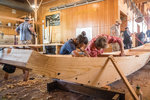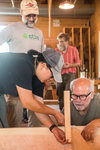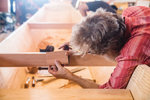Port Townsend is known for its dedication to preserving traditions of wooden boat building and at this year’s Wooden Boat Festival, which starts Friday, Sept. 6, hands will be linked across the Pacific Ocean to other cultures trying to preserve traditional techniques.
This item is available in full to subscribers.
We have recently launched a new and improved website. To continue reading, you will need to either log into your subscriber account, or purchase a new subscription.
If you had an active account on our previous website, then you have an account here. Simply reset your password to regain access to your account.
If you did not have an account on our previous website, but are a current print subscriber, click here to set up your website account.
Otherwise, click here to view your options for subscribing.
* Having trouble? Call our circulation department at 360-385-2900, or email our support.
Please log in to continue |
|



Port Townsend is known for its dedication to preserving traditions of wooden boat building and at this year’s Wooden Boat Festival, which starts Friday, Sept. 6, hands will be linked across the Pacific Ocean to other cultures trying to preserve traditional techniques.
Douglas Brooks, a boat builder, writer and researcher is hoping to help Japanese boat builders keep their craft going. Under the tutelage of several traditional boatbuilders, including Koichi Fujii, the last professional builder of taraibune, or tub boats on Sado Island, Brooks has learned the craft of building traditional Japanese river boats.
Students in his five-day workshop at the Northwest Maritime Center have taken on some of these techniques, too. In the workshop, the class of nine spent five days building a 23-foot boat from designs that come from the Shinano, a large river that drains a major basin west of Tokyo to the Sea of Japan.
Even experienced boat builders and woodworkers found new ways to make wood joints water-tight.
“There are different theories of construction, different techniques,” said Brad Dimock, a student in the class who owns a boat building company in Arizona. “It has crazy edge nailing that takes quite a bit of time. Every time I learn some crazy new technique that doesn’t apply, somehow it does in the end.”
Students “edge nailed” planks together with flat steel nails that were hand forged by boat shop manager Riley McMath. There is also no planing in Japanese building techniques, Brooks said, and instead students fitted planks by running a special boat-building handsaw between pieces of wood.
For Brooks, teaching these special techniques is part of his mission to preserve traditional boat building.
“The craft is in crisis,” he said. “There are no apprentices. So part of what I want to do is record the techniques in an attempt to preserve the craft.”
Brooks is currently fundraising to go to Japan and study boat building with 86-year-old Hideto Bansho, the last known boatbuilder of the Echigo region on the Sea of Japan. There, Brooks will work with Bansho to build a small fishing boat called a tenmasen.
The boat building workshop is leading up to the Wooden Boat Festival, where the boat shop will be decorated and themed for Japanese Boat Building.
Not only will Brooks be giving a presentation on Japanese boat building, but there will also be a traditional Shinto launch ceremony for the boat the students made, with a Shinto ritual and Taiko drumming by Japan Creative Arts.
“There is a purification ritual, which purifies the boat as well as the boatbuilders,” Brooks said. In the Shinto religion, ‘Kami,’ which roughly translates to spirit, is in all things, including people, animals, and objects.
“By ritualising and celebrating the various Kami, it brings humans closer to the divine,” Brooks said.
The launch is scheduled for 12:30 p.m. on Sunday at the NW Maritime Center marina basin.
“This is tied into the festival because this year we are focusing on exposure into other boat building traditions,” said Riley McMath, boat shop manager at the Northwest Maritime Center. “There’s a lot of local historical precedence for this as well because of what went on in British Columbia.”
The NW Maritime Center offers a class on the history of Japanese boat builders in British Columbia during Wooden Boat Festival with presenter Tad Roberts at 1:15 p.m on Sept. 7 as well as several other Japanese boat building classes and presentations. For a full schedule, see last week’s edition of The Leader or log onto woodenboat.org.